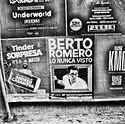marko_trebusak
Member
Hi,
I'm experimenting with multiple hits Pd printing at the moment (thank you Dave) with Na2 method. And beside increase in Dmax, I would also like to achieve duotone effect. I'm quite pleased with warm tone of sodium oxalate at higher temperature, so now I'm searching for solution for cold tones. I tried developing with ammonium citrate for this, and while with fresh developer results are in the right direction, I don't think I'm prepared to throw away developer after each session. I tried selenium toning, but with no convincing results. On my list for experimentation are sizing with gelatin and polyvinyl alcohol in sensitizer. So did anyone out there experimented with alternative developers (Dick Arentz in his book mentions two) or some other trickery?
Cheers,
Marko
I'm experimenting with multiple hits Pd printing at the moment (thank you Dave) with Na2 method. And beside increase in Dmax, I would also like to achieve duotone effect. I'm quite pleased with warm tone of sodium oxalate at higher temperature, so now I'm searching for solution for cold tones. I tried developing with ammonium citrate for this, and while with fresh developer results are in the right direction, I don't think I'm prepared to throw away developer after each session. I tried selenium toning, but with no convincing results. On my list for experimentation are sizing with gelatin and polyvinyl alcohol in sensitizer. So did anyone out there experimented with alternative developers (Dick Arentz in his book mentions two) or some other trickery?
Cheers,
Marko
Last edited by a moderator:





